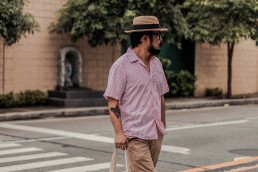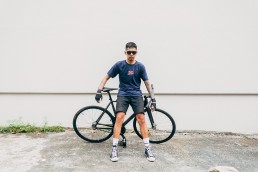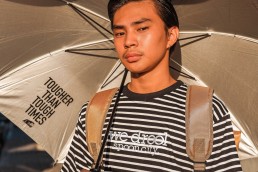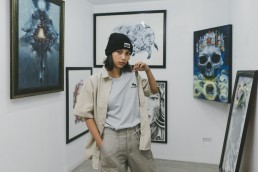
Back in January 2020, Vogue Italia made a statement by choosing to have their content illustrated rather than photographed in a move towards embracing sustainability. Editor-in-chief Emanuele Farnetti described the carbon-heavy shoots they needed to execute for the September 2019 issue—known as the biggest of the year with this: “One hundred and fifty people involved. About 20 flights and a dozen or so train journeys. Forty cars on standby. Sixty international deliveries. Lights switched on for at least ten hours nonstop, partly powered by gasoline-fueled generators. Food waste from the catering services. Plastic to wrap the garments. Electricity to recharge phones, cameras…”
This move was also met with scrutiny, and this is not lost on Farnetti. “I think that the most honest way to face a problem is starting by admitting it. That was our way to say that we know we are part of a business that is far from being sustainable,” he added.
It’s undeniable that the fashion industry’s mark on the environment is too powerful to simply ignore. In fact, 10% of the world’s carbon emissions is attributed to the industry. It is also the second largest consumer of the world’s water supply. The industry throws away just as much as it pumps out—with 85% of textiles ending up in the dump each year.
Photographer — Zaldine Alvaro
While various fashion brands have come up with ways to lessen their environmental impact, one method has been constantly surfacing recently: upcycling. But what is it exactly? It is the creative reuse of clothes and materials and turning into something functional.
Russell Villafuerte, through his brand STRONGVILLAGE, has been transforming wastes into functional and stylish pieces at a very young age. “My mom used to quilt a lot and she used retasos to make them. Growing up, we have quilted pillowcases, quilted hats, quilted table runners, you name it.”
He sat down with us to discuss his approach on sustainability and upcycling, his most recent collaboration with Human, and how sustainable brands can guide fast fashion brands in a non-disruptive manner.

How do you personally define sustainability?
Sustainability for me, in terms of fashion, must include the basic 3 Rs — reduce, reuse, and recycle. You can also probably add upcycling there. It’s all about consuming less and buying quality clothes that will last—not clothes you easily dispose after one or two uses.
There’s a current notion that sustainable clothes are expensive. What’s your point of view on this?
It is not just a notion. When a brand creates a shirt through non-sustainable approach, the process is a lot easier, and the materials are a lot cheaper. You buy a fabric then have it sewn, and you’re done. When you opt to do it sustainably, you add four to five more layers in the process. Especially for me with the upcycling method, you first need to find material like an old pair pants. Then you need to wash and sanitize it. After that, you need to deconstruct it and re-wash. You then need to make a pattern for it since you need to maximize the material you have on hand. That’s the time you can have it sewn to your desired design. And the process ends with washing it again to ensure it’s properly cleaned. There’s so much more process to doing it sustainably so it’s understandable that it’s going to cost a lot more than the clothes we’re used to. But the point is not quantity of clothes, but quality of the clothes you have in your arsenal.
What usually comes first—the design or fabric/garment that you guys deconstruct?
For us in STRONGVILLAGE, we already have existing silhouettes that we do over and over. For example, the kimono jacket. It’s just one style, but we can do infinite iterations of it because each piece will always look unique because of the materials we use. Most of the time we get materials from donations, ukays (thrift shops), and warehouses. It’s material-based most of the time.
Do you feel limited in terms of design freedom because of the challenges of upcycling?
I don’t find it limiting. I find it more challenging. I don’t think every designer can do this because upcycling adds extra layer of processes compared to regular designing. For me, it’s more fun. It’s not for everyone, but I love doing it. I’ve been doing this for a long time now.

How did you set the direction for STRONGVILLAGE?
Since we cannot control the sizing of our pieces, the easiest way to address that is to make clothes that are oversized by style so it can accommodate several sizes, as well as genderless. I take inspiration from global streetwear culture by taking bits and pieces and forming them together like Japanese streetwear and American streetwear.
I am also heavily influenced by the rave, punk, and goth scene I experienced in the early 2000s when I was in college. I used to go to these events a lot, and back then people would go in all kinds of deconstructed clothes. Clothes from ukay or whatever they find at home would be put together to make a completely different look.
The main client of STRONGVILLAGE is me. I don’t make designs in STRONGVILLAGE that I don’t wear. I am my brand’s number one client. (laughs)
One of the challenges with this kind of business model is replication. When a certain piece gets attention, you can’t scale up. How do you navigate this challenge?
I don’t think I can navigate that because there really is no way to scale up production for upcycled clothes due to the challenge of finding the exact same material in bulk. But that’s okay. I have embraced the fact that everything we release is one-off. Our products usually take on the same silhouettes—kimono jacket, suits, pants—but different style depending on fabric. One way of being able to do this, though, is if we partner with a bigger brand like our recent Human collaboration because they have a lot of overruns and factory textiles so you can scale up in quantity and size variations.
Speaking of the Human collaboration, how did it come about?
It started when the owner of Human, Suyen Yap, ordered jackets and several items from STRONGVILLAGE. She got lots of compliments after that, and that’s how the whole thing started. We kicked it off last March 2021 so it’s a year in the making. I was initially surprised because at the time she reached out and offered a collaboration to me, I only had 300 or 400 followers on Instagram so I was really skeptical. (laughs)
Human is a fast fashion brand and STRONGVILLAGE is a sustainable brand, how do you draw the fine line between the two sides in this collaboration?
I think this is the first collaboration between a big RTW brand and a sustainable brand in the Philippines. They [Human] are learning, and I’m happy to share the advocacy to others. I hope it [sustainability] is not just for bandwagon because it’s “trendy.” I hope other brands can follow. If they have a lot of overruns that they will just throw away or put up on sale. Why not give them to us or other sustainable brands and rework these materials? That’s how I see it.
For the collaboration, we made use of Human’s overruns and factory textiles to turn it into upcycled clothes.
Are we expecting more collaborations with Human? Is there a new collection in the pipeline?
Yes, that’s actually what I want to do—to service bigger brands and to encourage them to practice sustainability in a way that they can readily do—without adding stress or additional expenses for them because they are usually scared to enter the space because they think it will cost them more. We are here to encourage them and say that it is not that difficult and not that costly as long as they are willing to explore and try.
Do you think fast fashion and sustainable brands can work together?
I am hopeful. I think there is a chance especially if the companies are willing to try and listen and take a risk. Why not? Everything is doable, but hopefully it would encourage them to do it again if they have done it before or try it if they haven’t.
They just need a little push, but maybe since sustainability is getting the spotlight now, they would be more encouraged. I hope that it doesn’t just fade like regular trends because what would happen if consumers stop caring about it, right?

There are many people who are trying to pursue sustainability these days, what advice will you give?
Be more patient, persistent, and creative. Not just in doing your designs, but in sourcing your goods and material as well.
For those who haven’t started pursuing sustainability, what’s the best way to start?
The best way to start is by not just simply throwing away stuff you no longer use. At the end of the day, even if you don’t de-construct them, you can always give it to your neighbor in need or donate it to charities and orphanages. You don’t need to know fashion or be a fashion designer to incorporate sustainability with your clothes. You can do it in small ways. The simplest, smallest steps can make a difference.
SUPPORT PURVEYR
If you like this story and would love to read more like it, we hope you can support us for as low as ₱50. This will help us continue what we do and feature more Filipinos who create. You can subscribe to the fund or send us a tip.















